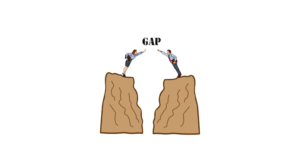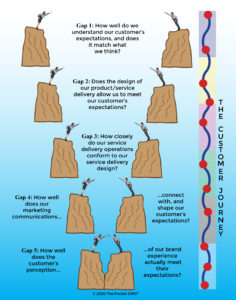Service Quality Management (SQM) methodology is not new. Nor is SQM necessarily associated with Customer Experience Management (but it should be…) In fact, SQM is probably more intricately linked to Business Process Management when used for problem-solving approaches.
The “Five Gaps” associated with SQM are particularly relevant to customer experience management, and they are most useful in considering an action plan coming out of a Customer Journey Mapping exercise.
Your customer has formed an expectation of service level with your brand based on four important criteria and influences:
- Word of Mouth Communication, which includes Social Media, Ratings and Reviews, Brand Reputation Management, and Traditional word of mouth referrals. These are also the stories people tell about you outside of your presence that are not captured on SM, ratings, and reviews.
- The customer’s own changing personal needs in uncertain environments, like today.
- Past experience, and the impressions and expectations formed from that experience.
- The perception and expectations formed from your communicated value proposition and marketing.
You and your management team have formed a perception of your service delivery based on several customer feedback methods including,
Customer Satisfaction Surveys, Digital Surveys, Complaint and Dispute Resolution feedback, Call Center monitoring, Social Media Listening Posts, and Focus Groups, among others.
You feel like you have a handle on this.
So why is your NPS score mediocre, and not improving? Why are customer retention and lifetime value lower than you would like them to be, or below the industry average?
Enter the Five Gaps of SQM, and Customer Journey Mapping, giving you lines of sight into your current mediocre results.
Gap 1: How well do we understand our customer’s expectations, and does it match what we think? This is the largest gap where companies are the most surprised.
Gap 2: Does the design of our product/service delivery allow us to meet our customer’s expectations? This gap is often ignored and frequently skipped.
Gap 3: How closely do our service delivery operations conform to our service delivery design? This gap surfaces hidden glitches that undermine exceptional delivery
Gap 4: How well does our marketing communications connect with, and shape our customer’s expectations? Most companies start here, but without knowing what’s in the first three gaps, it’s a shaky foundation.
Gap 5: How well does the customer’s perception of our brand experience meet their expectations? This is another place where companies like to focus attention first, but often don’t dig into the other gaps.
Approaching your Customer Journey, Stakeholder Journey, Employee Journey, and Third-Party Partner Journey mapping allowing you to close these five gaps can help you build a better roadmap to:
- Understanding the Customer
- Designing Great Customer Experiences
- Measuring to Drive Performance and Deliver a Great Experience
- Governance of the CX Delivery across your Organization.
For a positive bottom line in the Experience Economy, companies must close these gaps fast. You need a focused methodology to uncover the disconnects between you and your customers, along with a strategy to move forward with confidence. Not knowing exactly what’s in the gaps keeps you spinning in circles. It is a changing world. To keep and grow customers, close these gaps using customer journey mapping and SQM methodologies today.






